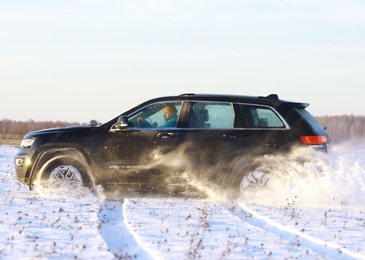“Police U-turn” is very easy to perform and does not require much effort from the driver or the car. However, it is an important part of professional driver training, as it provides insight into how to deal with a total loss of control of the vehicle. For example, with its rotation at high speed. The algorithm for performing this exercise, as already mentioned, is not very complicated. Acceleration, clutch, steering wheel in pointless range, steering wheel straight ahead, stabilization. But of course there are nuances. Portal “AutoVzglyad” tells – what.
In almost every movie where car chases are present, you can see how the main character, who is also a top-level professional, performs a “police turn”, confusing his opponents. Perhaps that is why motorists have formed a strong opinion that this element of the driver’s art belongs to the category of the highest complexity and is available only to super agents.
In fact, a “police U-turn” as such can be performed by absolutely anyone, even without sufficient driving experience. The main thing here is to follow the correct sequence of actions. Which, we note, is absolutely independent of the type of drive, the presence or absence of an “automatic” and “handbrake”.
By the way, a very important point is that in no case should the “handbrake” be used here. This can cause the car to go into a side skid rather than a compact turn in a gentle arc. Which will surely lead him into a ditch or into the gentle embrace of a tall and strong pillar. To perform a maneuver, we really only use the steering wheel, which allows the car to rotate compactly around its own center of mass. And for this you need to accelerate. At a speed of 30 km / h, a “police turn” is possible even on asphalt. The algorithm of actions is simple.
We accelerate backwards in a straight line. Then we squeeze the clutch or put in neutral and turn the steering wheel as quickly as possible all the way to the right or left with the same quick return to the “straight” position. Then we smile and wait. The car will start spinning around its center of gravity and when it turns 180 degrees it will stabilize and roll in a straight line. Then we put the gear on and take off proudly in the right direction. All.
But this does not mean at all that you should immediately try to perform a trick on the road. Despite all its simplicity, things can go completely wrong. Especially if you make a mistake in some “little thing” or, in a state of stress, hit the brakes at the wrong time. In general, the “police turn” is more of an advanced driver training exercise.
In addition, it is instructive only from the point of view of understanding how it is possible to stabilize the vehicle, which came into rotation at high speed and even on the snow-ice layer. All attempts to stabilize the car with braking, accelerator and steering are usually ineffective, because the driver is constantly delayed and does not have time to properly assess the situation.
But on the other hand, he knows that the car is spinning around its center of gravity, which is still moving in the direction of the velocity vector. That is, in a straight line. And in this situation, you just need to put the steering wheel in the “straight” position and let the wheels roll freely by pressing the clutch or putting the selector in “neutral”. As a result, when the longitudinal axis of the car rotates along the velocity vector, it will stabilize. This is because the sliding friction of the wheels on the road is greater than the rolling friction. And if the car is stabilized stern forward, then here you can recall the skills of performing a “police turn” to return it to the correct position on the road. However, if you have not perfected this technique to automaticity, it is better to just choose a reasonable speed and take into account the road conditions.
In almost every movie where car chases are present, you can see how the main character, who is also a top-level professional, performs a “police turn”, confusing his opponents. Perhaps that is why motorists have formed a strong opinion that this element of the driver’s art belongs to the category of the highest complexity and is available only to super agents.
In fact, a “police U-turn” as such can be performed by absolutely anyone, even without sufficient driving experience. The main thing here is to follow the correct sequence of actions. Which, we note, is absolutely independent of the type of drive, the presence or absence of an “automatic” and “handbrake”.
By the way, a very important point is that in no case should the “handbrake” be used here. This can cause the car to go into a side skid rather than a compact turn in a gentle arc. Which will surely lead him into a ditch or into the gentle embrace of a tall and strong pillar. To perform a maneuver, we really only use the steering wheel, which allows the car to rotate compactly around its own center of mass. And for this you need to accelerate. At a speed of 30 km / h, a “police turn” is possible even on asphalt. The algorithm of actions is simple.
We accelerate backwards in a straight line. Then we squeeze the clutch or put in neutral and turn the steering wheel as quickly as possible all the way to the right or left with the same quick return to the “straight” position. Then we smile and wait. The car will start spinning around its center of gravity and when it turns 180 degrees it will stabilize and roll in a straight line. Then we put the gear on and take off proudly in the right direction. All.
But this does not mean at all that you should immediately try to perform a trick on the road. Despite all its simplicity, things can go completely wrong. Especially if you make a mistake in some “little thing” or, in a state of stress, hit the brakes at the wrong time. In general, the “police turn” is more of an advanced driver training exercise.
In addition, it is instructive only from the point of view of understanding how it is possible to stabilize the vehicle, which came into rotation at high speed and even on the snow-ice layer. All attempts to stabilize the car with braking, accelerator and steering are usually ineffective, because the driver is constantly delayed and does not have time to properly assess the situation.
But on the other hand, he knows that the car is spinning around its center of gravity, which is still moving in the direction of the velocity vector. That is, in a straight line. And in this situation, you just need to put the steering wheel in the “straight” position and let the wheels roll freely by pressing the clutch or putting the selector in “neutral”. As a result, when the longitudinal axis of the car rotates along the velocity vector, it will stabilize. This is because the sliding friction of the wheels on the road is greater than the rolling friction. And if the car is stabilized stern forward, then here you can recall the skills of performing a “police turn” to return it to the correct position on the road. However, if you have not perfected this technique to automaticity, it is better to just choose a reasonable speed and take into account the road conditions.
Source: Avto Vzglyad
Donald Salinas is an experienced automobile journalist and writer for Div Bracket. He brings his readers the latest news and developments from the world of automobiles, offering a unique and knowledgeable perspective on the latest trends and innovations in the automotive industry.















